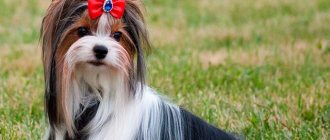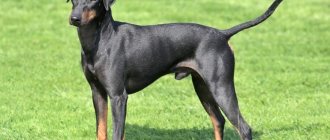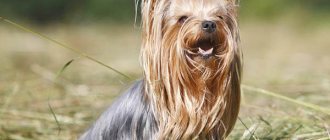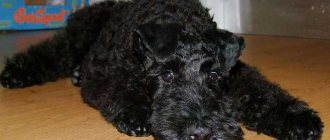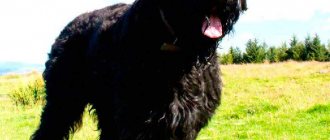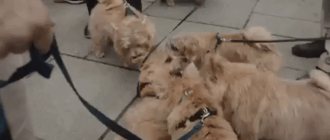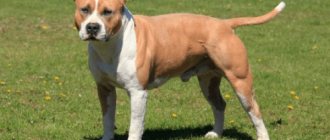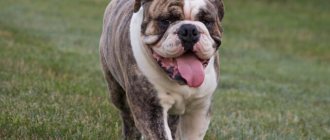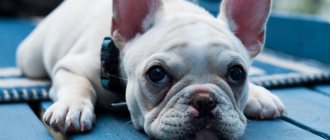Not so long ago, the Australian Terrier was an exclusively working breed, living on farms, working as a watchman and rodent exterminator. Today, the charming toy dog has become a companion. She is smart, cheerful and tireless, and does not require complex care. Very popular in its homeland, but little known outside of Australia.
Breed characteristics
| Short description | |
| Origin: | Australia |
| Conditions of detention: | House with private territory, apartment |
| Purpose: | Companion dog, herding dog |
| Color: | Sand, red, blue, gray-blue with a steel tint |
| Wool length: | Average length 6-7 cm. |
| Adult dog size: | The height of females is 20-24 cm, males 22-26 cm, weight of males is approximately 5-6 kg, females 5-7 kg. |
| Average life expectancy: | 13-15 years old |
| Walk: | Can be kept as an apartment dog without walking, but for proper development - 2 times a day |
| Physical activity needs: | Average physical activity requirement (walking 1 to 3 hours per day) |
| Fédération Cynologique Internationale (FIC) classification: | Group 3: Terriers, Section 2: Small Terriers |
| Puppy price: | From 12,000 to 30,000 rubles |
History of the origin of the species
From the etymology of the name one can judge that the birthplace of this breed is Australia. But there are still disputes. Since the Australian continent was a British colony, the terrier was most likely brought from England at the beginning of the 19th century. According to official information, the closest ancestors are the Yorkshire and English terriers.
The appearance of the Australian was constantly changing: at first he looked like his brothers, but as the blood mixed, he acquired his own unique appearance. Unlike its close relative, the Silkie Terrier, the Australian has hard, spiky hair, because it was bred for work: catching rats, small rodents and snakes. Thanks to his good reaction and sense of smell, he can sense danger from a great distance and inform his owner.
The first mention of these dogs dates back to 1820. Although the breed was first demonstrated much later in Melbourne (the center of the Australian state of Victoria) as a medium terrier. Silkies with soft, silvery fur were considered the standard. Australians with their reddish color were discriminated against until 1902. They were officially registered in 1933 by the British Canine Organization, and received worldwide recognition only in 1962.
Australia is considered the official homeland. This dog is a treasure here, so the removal of puppies is not free. Permission must be obtained.
Health
A study was conducted in the early 20s of this century. Several dogs from different countries were examined for the presence of genetic diseases. None of the dogs participating in the study were found to be prone to diseases of this kind.
These little dogs are amazingly healthy. Their only problem is their joints. Representatives of the breed may suffer from hip and elbow dysplasia.
Vaccinations
The first vaccinations are given by the breeder during the first 6 weeks of the puppy’s life. The owner only needs to carry out annual vaccination, which includes vaccination against infectious diseases and rabies.
Distinctive features
Since the breed was bred as a hunter of small rodents, the size of its representatives is small: 20-26 cm
in height at the withers . The standard is not divided into female and male, but females are usually smaller. Dogs weigh from 5 to 7 kg .
They are easy to care for and live comfortably in an apartment. There are standards by which the thoroughbred and purebred of a puppy are determined:
- The head is wedge-shaped, medium in size, proportional to the body. The skull is strong with a flattened forehead and a rounded occipital region. The muzzle is of medium length, tapering towards the nose. The transition from the forehead is moderately expressed. The jaws are strong, have a scissor bite, and the teeth are straight.
- The lips are thin and do not sag.
- The eyes are small, not set wide, and not bulging. The shape is round, the iris is in dark shades of brown. The eyelids are pigmented black. The look is attentive and intelligent.
- The nose is medium with open nostrils. Only black is considered the correct color.
- The ears are erect and it is not customary to crop them. V-shaped: the base is wide, the tip is narrowed (sharp or rounded). Cartilage tissue is thin and mobile.
- The body is low, elongated, but proportional to the height. The back is straight and does not transform during movements. The loin is narrow but strong; the thoracic region is expanded. The neck is short, wide, flowing into the back with a smooth curve, there is no dewlap.
- The tail is set high and vertical. It is customary to cut to medium length. The hair on the tail is short, without a tassel. If the tail is not docked, the shape is crescent-shaped without a loop.
- The limbs are shortened and strong. The hind ones are slightly longer than the front ones. The feet are round and small with hard dark claws.
- The coat is dense, harsh, and of medium length. It forms a mane on the neck and around the head. As a rule, dogs are not trimmed.
- The color can be of several types: steel, blue, red, sand. Puppies are born with black fur.
For any deviations from these standards, the dog may be considered defective and excommunicated from further participation in the reproduction of individuals.
Reviews
Olga: “We bought a girl, 2 months old, she lives with us for half a year. She immediately became a family favorite. I quickly got used to the tray. Fortunately, the terrier hardly misbehaves and doesn’t chew shoes. Barks not as often as we were afraid. Loves to be in company, in the center of attention. I made friends with the cat, they communicate without conflicts. Sometimes it gets a little tiring with the activity, but overall the impression is positive, we don’t regret one bit that we chose it.”
Artem: “We bought our daughter an Australian puppy two years ago. We were worried that there would be difficulties in caring for the terrier, but in vain. We bathe him sometimes, brush him often, there is no hair on the sofas or carpets. The dog treats guests calmly and is sociable. An absolutely problem-free dog, and my daughter is so happy.”
Anastasia: “Silky is a good and devoted friend, he will never let you get bored. But it takes a lot of time. The terrier knows how to have fun on his own, but more often he looks for company. Constantly asks to go outside. He behaves restlessly. So if you don’t like unnecessary fuss, then the dog is not for you.”
Photo of an adult dog
Photos of puppies
Features of character and behavior
Australian terriers are typical representatives of their group. They are active and love to play pranks: gnawing, breaking, digging, barking. They are quite hardy and unpretentious, unlike their “brother” York, they do not have a “Napoleon complex”, but do not like other dogs and pets on their territory. They are very affectionate with people, playful, and get along well.
It is not for nothing that representatives of the breed received companion status. They will share all the joys and sorrows of their owner, will be obedient and devoted.
Advantages
- Like all hunting dogs, terriers have developed sense organs from birth: nose, eyes and ears . This provides dogs with a good reaction and makes them not only hunters, but also watchdogs. Having noticed a stranger, the Australian Terrier will immediately notify the owner with a loud bark.
- They live well in small areas : apartments, enclosures. But the “sofa” lifestyle is not suitable for Australians. Their mischievous nature does not allow them to sit still, so pets need to be walked often and given exercise. Terriers will happily accompany you on hikes, travels and during sports activities.
- They get along with people easily. They will become cute, affectionate dogs that you can show to your friends. Relations with children are also good and friendly. Dogs are not considered as caregivers, but this is solely due to their small size.
- The intelligent and obedient terrier is easy to train and follows the owner's commands. Loves active outdoor games with a ball, frisbee, sticks, ropes and other toys.
Flaws
- This breed is characterized by pugnacity and intolerance towards other dogs. The Australian Terrier will not tolerate another male and will fight for leadership. It gets along quite well with the opposite sex, but it is better not to keep pets together.
- Prone to a wandering life. Without proper training, it is better to walk a terrier on a leash, otherwise he may run away and will not return: he feels quite comfortable in conditions of homelessness.
- They will hunt for any small prey they come across: from a rat to a cat. This can cause inconvenience when walking. Breeders should immediately get used to “gifts” from their pet in the form of a killed victim.
- And Australians are big pranksters
. Without walking and sufficient physical activity, these dogs will find something to do or have fun on their own: chew shoes, wallpaper, bark at passers-by or roommates.
Wirehaired or silky
The Australian Terrier has a rough coat. This is a working dog and long curls do not suit him at all. But there is a separate branch of this breed, whose coat is soft and flowing. They resemble the Yorkshire Terrier in appearance. Their fur reaches a length of up to 16 cm. These dogs are even rarer and more expensive than their wire-haired relatives. It is almost impossible to meet them in Russia.
In turn, grooming is simple and convenient. The Silkie Terrier practically does not shed, has no odor, and is perfect for people prone to allergies. The dog needs to be brushed frequently to keep its soft coat shimmering. If you leave it without care for several weeks, tangles will appear that all you have to do is cut it out.
Care and maintenance
These dogs completely adapt to the rhythm of their owner’s life. They are unpretentious in content.
They do not need regular haircuts,
they are bathed once every 2-3 weeks
, combed every day, but not intensively.
The main requirement for maintenance is constant training and walking. An active lifestyle for your pet properly develops its skeleton and strengthens its muscles. If the terrier lacks mobility, his character will deteriorate and he may become sad and irritated.
Nutrition
For a dog to fully develop, it is necessary to supply it with all vitamins and minerals.
The breeder has a choice:
dry food or natural food
.
In the first case, it is recommended to buy premium food that does not contain starch, corn and other substances harmful to pets. The portion should be calculated using the formula 20% of its weight.
Adult dogs are fed
2 times a day .
If the owner feeds the terrier with natural products, then he needs to include in the diet:
- Cereals, cereals, porridges;
- Vegetables and fruits;
- Meat of various types (beef, chicken, lean lamb, turkey, rabbit);
- Fish;
- Fermented milk products (cottage cheese, kefir);
- Eggs.
The main thing to remember is that a dog is not a pig; it cannot be fed with leftover food from the table. It is not advisable to give your pet dried, fried, pickled, fatty, sweet, or spicy food. You should also avoid bones, potatoes, onions, citrus fruits and flour products. It is important to mix vitamins and calcium into your food.
Health
This breed does not have genetic diseases that are passed on from generation to generation. Australian terriers are distinguished by strong immunity and health, however, some dogs still experience some diseases. Therefore, it is necessary to do age-specific comprehensive vaccinations to protect your pet, treat with flea and tick repellents, and periodically carry out deworming.
Vaccinations
Comprehensive vaccinations are given to all dogs, not excluding Australian Terriers:
- Vaccination against plague, hepatitis, leptospirosis, influenza and enteritis
(1.5 months, 2.5 months, 7 months, 12 months, and then annual vaccination); - Rabies vaccination
(first at 7 months, repeated every year, required for traveling abroad).
The puppy is given a special veterinary passport, in which the doctor must enter the dates of vaccinations and paste in drug labels. There are also sections that are filled out by the owners: frequency of deworming and treatment for external parasites.
After each vaccination, the dog must be provided with rest and incubation for 14 days. During this period, the activity of the protective function of the immune system decreases and there is a risk of contracting the virus.
Diseases
Features of the body structure (short legs and a strong body) can lead to dysplasia of the dog’s joints. This disease is characterized by bowed paws, swelling of the knees and elbows, lameness and pain. At the moment, there is the possibility of surgical treatment, but, as a rule, it does not provide a 100% recovery. The disease is passed on from the parents, so the breeder should inquire about their health before purchasing a puppy.
After treatment, the dog should not be overloaded. It is not recommended for your pet to actively jump and run. To avoid dysplasia, it is necessary to supply the terrier with calcium, monitor the diet and not overfeed.
In addition to joint deformation, some representatives of the breed had other diseases:
- Diabetes;
- Epilepsy;
- Sprained knees.
Walk
Despite their small size, Australian Terriers are very active. They need to run, sniff, hunt. If the dog is properly raised, contact with other animals is possible.
When keeping a pet in an apartment without the possibility of free access to the street, the regularity of walking is 2-3 times a day. Moreover, 10 minutes is not enough for a terrier. To throw out all the accumulated energy he needs time, at least 1 hour. If there is an area adjacent to the house and the dog can run freely, then walking is not necessary, but do not forget about training and training.
Grooming
- The Australian Terrier has a medium-length, coarse coat. It is not as obedient as Yorkies, but they do not need to be cut. Basic care consists of combing the pet once a day, bathing once every 2-3 weeks (shampoos are purchased at pet stores).
- Active shedding is not observed in this breed, but it is recommended to comb them more often in autumn and spring. In the summer, the dog must be examined for ticks; in case of a bite, veterinary services can be used. Experienced breeders know how to deal with this problem themselves, but it is better to turn to specialists. It is recommended to take blood tests.
- Ears and eyes are wiped with cotton swabs. Teeth are brushed with special pastes 1-2 times a week. The breasts usually fall out on their own, but if by the age of one they have not changed to primary ones, you should consult a doctor. It is necessary to monitor the condition of the nails and trim them as necessary.
In winter, dogs are dressed in protective overalls. In most cases, to protect the fur from bacteria, snow and dirt, and not to keep the pet warm.
Food Australian Terrier
Nutrition should be balanced and healthy. If you choose a type of feeding based on the consumption of ready-made dog food, carefully select the food that is intended for active dogs of small stature. Feed should only be of the highest class, and should not contain soy and by-products, dyes and flavors. Dry food that is sold by weight is usually inexpensive and of poor quality.
Therefore, it is better to choose more expensive food, although price is also not always an indicator of quality. It is best to consult a breeder or veterinarian on this matter. If you choose a type of animal feeding based on the consumption of natural products, also do not forget about quality and freshness. Food must contain proteins, fats, carbohydrates, vitamins, minerals and trace elements.
Healthy foods: lean lamb, turkey and rabbit meat; cottage cheese; eggs; greenery; vegetables and fruits. You cannot feed your dog fatty, smoked and pickled foods, ready-made canned food and various semi-finished products, sausages and other products from the supermarket. Dog dishes should contain a minimum amount of salt. There should be no spices at all; they have a negative effect on the dog’s sense of smell. You should also not give your dog tubular bones, potatoes, legumes, citrus fruits, sweets and chocolate.
HOW DO DOGS BARK IN FOREIGN LANGUAGES?
DOG SPEECH - HOW TO UNDERSTAND WHAT A DOG IS TELLING US?
SEVEN REASONS DOGS MAKE OUR LIVES BETTER
Mating
Australian Terriers become sexually mature at 15-18 months. Males may mount plush toys or household items. In this case, the pet should not be encouraged, but scolding it is also wrong. A puppy in adulthood may not respond to a female.
It is recommended to do the first mating on the bitch’s second heat, preferably 15-20 days. The pets must be walked together and brought to the male dog’s territory, where he can feel his strength. In case of size discrepancy, the owners should help the dogs: hold them, turn them around, choose a convenient place.
Repeated mating is possible either on the same day or after a week.
List of nicknames
It is better to choose a name for your pet that is sonorous, suitable for the temperament, but not long and easy to remember:
- Suitable nicknames for boys are:
- Archie, Charlie, Dick, Jack, Max;
- Sam, Barney, Bucks, Ace, Cujo, Flash, Hugh, Rocky, Leo, Mike;
- Nemo, Nick, Oscar, Umka, Twix, Hooch, Caesar, Elvis, Ian, Hulk.
- For girls:
- Gina, Bella, Maggie, Lady, Dina, Chelsea, Sophie;
- Astra, Alpha, Alice, Barbie, Gerda, Busya;
- Eva, Maya, Nyura, Puma, Ruby, Tuchka, Fiona, Coco;
- Ellie, Juno, Utah, Fanta.
You need to accustom your pet to its name as soon as it appears in the family.
Key points in training
You need to start training the Australian Terrier as early as possible. It is believed that already at the age of 2 months a puppy is able to understand its owner. Representatives of this breed are intelligent, but can be stubborn.
When keeping a pet in an apartment, you should accustom it to the tray. It is also necessary to develop a reflex to a nickname and teach basic commands:
- "Sit";
- "Near";
- "To me";
- "Lie";
- "It is forbidden".
Dog handlers recommend taking your pets through an obstacle course called “Agility.” This will help develop the dog's speed and agility. Aggressive training methods are prohibited; terriers are smart enough to understand the words of the owner.
Read about how to properly train a dog in the article: “Training a puppy: effective methods from dog handlers, learning commands at home.”
How to choose a puppy
There are not so many official breeders in Europe, in particular Russia. It is not recommended to purchase a puppy from an unverified company. Before purchasing, you need to ask about the puppy’s diet and living conditions. Inquire about weight and height. If possible, evaluate the parents live and find out about their diseases.
After this, you can evaluate the puppy itself. He must meet breed standards, be clean, well-groomed and happy. If your pet is interested in you, then you can take it without hesitation, because trust and love cannot be bought with money.
The cost of the Australian Terrier is high due to the uniqueness of the species. The official price varies from 12,000 to 30,000 rubles. You should not save on a puppy, because this can affect his behavior and health.
Buying a dog is always a joy, because it becomes a full-fledged member of the family. The Australian Terrier is not only loyal to its owners, but also has a cheerful character. He will always be able to help in difficult times with joyful barking and wagging of his tail. Looking into his eyes once, it is impossible not to fall in love with his purity and sincerity.
